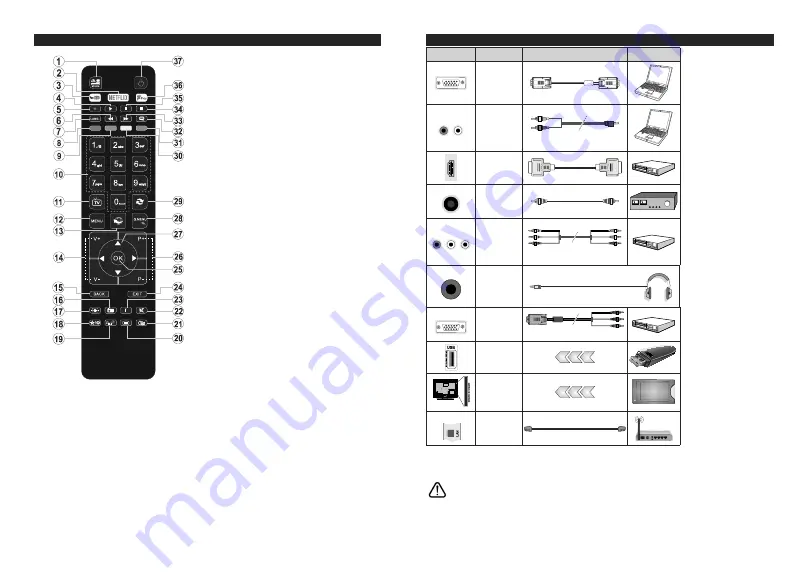
English
- 85 -
Remote Control
(*) MY BUTTON:
This button may have a default function depending on the
model. However you can set a special function to this button
E\SUHVVLQJRQLWIRU¿YHVHFRQGVZKHQRQDGHVLUHGVRXUFH
RU FKDQQHO$ FRQ¿UPDWLRQ PHVVDJH ZLOO EH GLVSOD\HG RQ
the screen. Now the MY BUTTON is associated with the
selected function.
Note that if you perform
First Time Installation
, MY BUTTON
will return to its default function.
1. Source:
Shows all available broadcast and content
sources
2.
1HWÀL[
/DXQFKHVWKH1HWÀL[DSSOLFDWLRQ
3. YouTube:
Launches the YouTube application
4. Play:
Starts to play selected media
5. No
Function
6. Rapid
reverse:
Moves frames backwards in media
such as movies
7. Language:
Switches between sound modes (analogue
TV), displays and changes audio/subtitle language
(digital TV, where available)
8. Red
button
9. Green
button
10. Numeric buttons:
Switches the channel, enters a
number or a letter in the text box on the screen
11. TV:
Switches to TV Source
12. Menu:
Displays TV menu
13. Internet:
Opens the portal page, where you can reach
many web based applications
14. Volume
+/-
15. Back/Return:
Returns to previous screen, opens index
page (in TXT mode)
16. Favourites:
'LVSOD\VXVHUVSHFL¿HGIDYRXULWHFKDQQHOV
17. Screen:
Changes the aspect ratio of the screen
18. My button 1 (*)
19. Media
browser:
Opens the media browsing screen
20. Text:
Displays teletext (where available), press again
to superimpose the teletext over a normal broadcast
picture (mix)
21. EPG (Electronic programme guide):
Displays the
electronic programme guide
22. Mute:
Completely turns off the volume of the TV
23. Info:
Displays information about on-screen content
24. Exit:
Closes and exits from displayed menus or returns
to previous screen
25. OK:
&RQ¿UPVXVHUVHOHFWLRQVKROGVWKHSDJHLQ7;7
mode), views channel list (DTV mode)
26. Pro / -
27. Directional buttons:
Helps navigate menus, content
etc. and displays the subpages in TXT mode when
pressed Right or Left
28. Quick
Menu:
Displays a list of menus for quick access
29. Swap:
Quickly cycles between previous and current
channels or sources
30. Yellow
button
31. Blue
button
32. Subtitles:
Turns subtitles on and off (where available)
33. Rapid advance:
Moves frames forward in media such
as movies
34. Stop:
Stops the media being played
35. Pause:
Pauses the media being played
36. Freeview
Play:
Connects to the Freeview Play platform
where you can access available catch-up TV services
37. Standby:
Switches On / Off the TV
English
- 86 -
Connections
Connector
Type
Cables
Device
VGA
Connection
(back)
AUDIO IN
PC/YPbPr
Audio
Connection
(back)
YPbPr/PC Audio Cable
HDMI
Connection
(side&back)
SPDIF
SPDIF
(Coaxial Out)
Connection
(back)
BACK AV
Back AV
(Audio/Video)
Connection
(back)
AV Cable
HEADPHONE
Headphone
Connection
(side)
YPBPR
YPbPr Video
Connection
(back)
PC to YPbPr Connection Cable
USB
Connection
(side)
CI
Connection
(side)
CAM
module
LAN
Ethernet
Connection
(back)
LAN / Ethernet Cable
See the illustrations on the left
side. You can use YPbPr to VGA
cable to enable YPbPr signal via
VGA input. You cannot use VGA
and YPbPr at the same time.
To enable PC/YPbPr audio, you
will need to use the back audio
inputs with a YPbPr/PC audio
cable for audio connection.
When using the wall mounting
kit (available from a third party
in the market, if not supplied),
we recommend that you plug all
your cables into the back of the
TV before mounting on the wall.
Insert or remove the CI module
only when the TV is SWITCHED
OFF. You should refer to the
module instruction manual for
details of the settings. The/Each
USB input of your TV supports
devices up to 500mA. Connecting
devices that have current value
above 500mA may damage your
TV. When connecting equipment
using a HDMI cable to your TV,
to guarantee s
uf
¿FLHQW LPPXQLW\
against parasitic frequency
radiation, you have to use a high
speed shielded (high grade) HDMI
cable with ferrites.
If you want to connect a device to the TV, make sure that both the TV and the device are turned off before making
any connection. After the connection is done, you can turn on the units and use them.






























